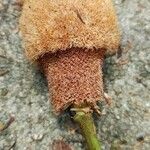Tree to 50 m high, 2.5 m in diameter. Leaves alternate, primary rachis including petiole 18-42 cm long. Gland on petiole 1 or sometimes 2, 1.5-4 cm from base, in fresh material raised c. 1 mm, 0.5 cm long; smaller glands on primary rachis between ultimate pairs of pinnae. Pinnae 14-31 pairs, opposite or subopposite especially in middle of leaf, the lower pinnae often caducous, rachis 8.7-11.5 cm long. Leaflets 52-72 pairs, somewhat sigmoid, 6-10.5 by 1-2 mm, margins of adjacent leaflets contiguous, with stiff white hairs around margin, scattered on upper surface and sparse on lower surface; apex acute, base auriculate on proximal side, main nerve central, sigmoid, and curved towards distal margin at apex. Sapling leaves larger, to 62 cm or more long, the leaflets up to 82 pairs per pinna, 14.5-18 by 2.5-3.5 mm. Peduncles usually c. 4-7 per compound inflorescence reaching maturity, alternate, 8.5-33 cm long. Capitula 5.5-6.7 cm long, somewhat bi-globose at an thesis, with central constricted nectar-secreting region 2.1-2.5 cm in diameter, short basal staminodial region somewhat broader, to 3 cm in diameter, and apical fertile part elliptical, 3.1-4.5 cm in diameter, or less in dried material. Flowers bisexual. Calyx 9-10.5 mm long including pseudopedicel of 1-2 mm, and the largest lobes 1-1.5 mm long; corolla 10-11 mm long, the apical lobes 1-1.5(-2) mm long, rough on outer surface, then united below for c. 2 mm, then free towards base; filaments exserted 2-3.5 mm beyond calyx, the staminal tube 5-7.5 mm long. Pods strap-shaped, flat or rarely twisted (not in Malesia), the valves woody, rough, scarcely or not corrugated over seeds, glabrous with a reticulate network of fine cracks, and larger cracks developing between the seeds in old pods, the veins prominent across the width of the pod as a coarse network, sutures not thickened, 20-33 by 3.9-5.5 cm, the base abruptly attenuate into a stipe 6-15.5 cm long; inner surface of valves smooth, cream-coloured, lacking pulp, indented round each seed. Seeds c. 12-19 per pod, elliptical in outline, lying horizontally across width of pod, c. 1.4-2 cm long; testa hard, dark brown.
More
A large tree. It grows up to 50 m high and can be 2.5 m across the trunk. There are often buttresses. The bark is smooth and can be finely cracked. The leaves are compound. The first leaf stalk and axis is 18-42 cm long. There is a gland on the leaf stalk 1.5-4 cm from the base. There are 14-32 pairs of branches of the leaf and 52-72 pairs of leaflets. They are slightly S shaped and 6-11 mm long by 1-2 mm wide. The edges of the leaflets overlap. There are stiff white hairs around the edges of the leaflets. The flower stalks have a compound flower cluster. The fruit are pods which are flat and strap shaped. The pods are 20-33 cm long by 3.9-5.5 cm wide. There are 12-19 seeds per pod. They lie horizontally across the pod. They are 1.4-2 cm long. The seed coat is hard and dark brown.
Trees, to 30 m tall. Branchlets brown. Leaf rachis more than 30 cm, glabrous or pubescent; petiolar gland elliptic to circular, 2-4 mm; pinnae 20-30(-42) pairs, pinna rachis 9-12 cm; leaflets 50-60 pairs, falcate or slightly sigmoid, linear, 5-10 × 1-2 mm, lateral veins inconspicuous, base truncate, apex acute. Heads 3-4 cm in diam.; peduncles pendent, 20-45 cm. Flowers small. Calyx tubular, ca. 6 mm. Corolla tubular, 10-11 mm, 5-lobed; lobes 1-1.5 mm, villous. Stamens 10; filaments exserted 2-3.5 mm beyond calyx, base adnate to collar. Ovary stipitate. Legume straight, strap-shaped, flat, 20-36 × 3-4.5 cm, glabrous, base attenuate into a stipe 6-15 cm. Seeds 13-21, black, ovoid, ca. 2 cm, hard. Fr. Feb-Apr.
An upper canopy tree in lowland rain forest, mixed deciduous and dry evergreen forests, sometimes common; at elevations from sea level to 600 metres, occasionally ascending to 1,300 metres.
More
A tropical plant. It grows in lowland rainforest and dry evergreen forest. They occur from sea level to 600 m altitude but occasionally up to 1,300 m.
Uses Seeds, bark and sometimes leaves are reported as having medicinal uses (Burkill, Heyne, Hi schhorn, Perry, 11.cc.). The bark is used against scabies, boils, and abscesses, and the pods, pounded with water, are used as a hair shampoo. Ripe seeds, roasted and powdered, can be ingested as a medicine for colic, flatulence and stomach ache, or used in remedies for cholera or menstrual cramps. Powdered seeds are applied externally to wi unds, ulcers, and the abdomen for pain. Leaves m y also be ground up as an ingredient in a retried / for colic. The seeds may be eaten as a substitute tor those of P. speciosa after roasting, or when young, but they have a bitter flavour. Germinated seeds are consumed in Thailand (Nielsen & Santisuk, l.c.).
More
The seeds are bitter but may be eaten after roasting or boiling. The ripe fruit are eaten. The germinated seeds are eaten. The young tender pods are cooked and eaten, especially with fish. The leaves are boiled and eaten.


